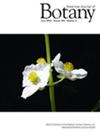Diversification of the stem vascular system in a clade of recent radiation and multiple habit transitions: The Bunchosia clade (Malpighiaceae)
Abstract
Premise
Within the Malpighiaceae, the Bunchosia clade is distinctive for its significant habit variation and abundance of different vascular variants. However, the processes underlying the diversification of the vascular system over time and the ontogenetic events involved remain unclear. Focusing on the Bunchosia clade, this study explores how new vascular configurations evolve in Malpighiaceae and the factors driving this diversification.
Methods
We analyzed stem ontogeny in 19 species representing all six genera of the Bunchosia clade, sampling from the apex to the base of the plants. We used the phytools package in R to map the entire stem ontogenies onto the most recent phylogeny estimate of Malpighiaceae, identifying the developmental modifications and processes involved in stem diversification within the clade.
Results
The ancestral condition of the clade was inferred to be a lianescent habit with regular stem anatomy. Over evolutionary time, two independent transitions to a self-supporting habit were inferred to have occurred. We identified five ontogenetic pathways, which led to distinct vascular system arrangements. Additionally, we propose two new records of cambial variants for the family.
Conclusions
From a regular secondary growth condition, different vascular variants evolved in a short period of evolutionary time in this clade. The self-supporting habit appeared twice: (1) in Bunchosia, maintaining a plesiomorphic regular secondary growth, and (2) another in Echinopterys, where the self-supporting habit retained the vascular variant inherited from the ancestor of the subclade. Our study provides insights into how stem vasculature diversified in lianescent clades and how it is related to habit transitions.





 求助内容:
求助内容: 应助结果提醒方式:
应助结果提醒方式:


